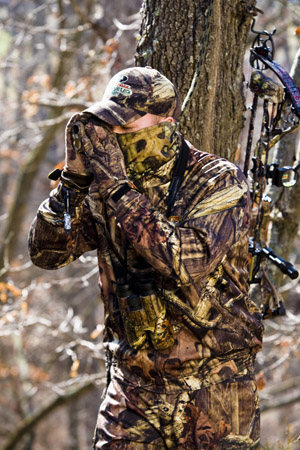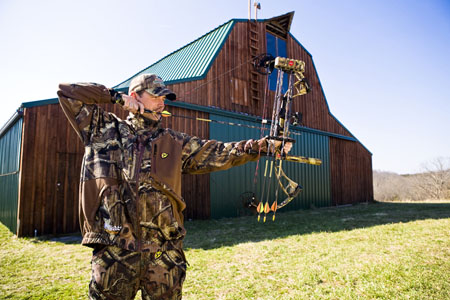 Straight Down Shooting Is Straight Wrong
Straight Down Shooting Is Straight Wrong
A quick, humane shot at a deer beneath your stand is unlikely. Consider the backbone. The spinous processes (tough bony protrusions sticking up from the backbone) present a formidable object, often leading to deflections, at best. In spite of faster, more efficient bows producing more kinetic energy than ever, this shot is far from a done deal. Should you manage to achieve sufficient penetration, the kill zone isn't very forgiving; you'd have to luck out and sever the pinkie finger-thin vena cava, a main artery running to the heart for a surefire kill. But what usually happens is a broadhead failing to split the medistinal membrane separating both lungs; a single-lung shot is the result. Whitetails can travel a long way powered by only one lung, and those that eventually expire will be exceedingly difficult to recover, even for accomplished trackers.
Naturally, the only sane solution is letting the buck put some more real estate between the two of you so both lungs are exposed. But what's a good distance? The answer is more than you think.
 Perceived Distance vs. Real Distance
Perceived Distance vs. Real Distance
Most bowhunters are accomplished shots. They take their craft—tuning, practicing, scouting, researching—seriously. There is no more dedicated segment of hunting society. But life isn't always fair. Which brings us to a unique circumstance that's so simple it's complicated. Unless you do your homework, you're inviting trouble whenever you set up a treestand for a tight shot. Which, of course, is any time you enter the woods, because point-blank bucks are virtually unavoidable. Take the rut. Legendary are tales of bucks suddenly materializing at the base of a treestand after a tactical rattling session. And apart from the rut, bucks are just as likely to meander near as far, since they don't stick religiously to trails like does. So you need to come prepared for point-blankers.
Most shots are missed high from a treestand for four distinct reasons:
1) The ballistics of shooting upward or downward angles
2) A deer's body appears smaller because more of its back and less of its side is exposed
3) Bowhunters often "underdraw," causing the arrow to be released short of the valley of the force-draw curve
4) Archers fail to bend sufficiently at the waist, thereby compromising form by altering anchor point and shoulder position. These are largely mental errors that are easily corrected. Learn to aim for the horizontal distance, and you'll shoot pretty much where you aim.
For example, suppose my treestand is 21 feet above ground and a buck appears 25 yards from the anchor point of my arrow (in this instance, where the knuckle of my right forefinger rests against my right ear lobe). If my geometry is correct, the horizontal distance would be exactly 24 yards, not 25. Now suppose the buck inches closer to 15 yards from my anchor point; the horizontal distance is now 13 yards. If the buck creeps to 10 yards, the horizontal distance is only 7 yards. And at 8 yards from my anchor point the buck is really only 4 yards. As you can see, the closer the buck gets, the wider the gap between "reality aiming" and "perceived aiming."
A 25-yard shot isn't affected much by the real/perceived gap in range estimation. But a point-blanker could be another matter. You must practice this shot (from a treestand!) because it can be fickle. As indicated, the exposure of both lungs decreases as real (horizontal) distance decreases. In addition, an arrow trajectory issue must be negotiated.
 How to Aim
How to Aim
The typical modern compound bow is set up for precise aiming with either a moveable 20-yard sight pin or multiple pins matched to arrow trajectories at various distances. With the 10-yard sight pin going the way of the Pterodactyl, which sight pin is the correct one for a 5-yard shot? Depends. How heavy is your arrow? How short (or long) is your bow? Its brace height? Your arrow's velocity? Outside temperature? Fact is, these factors affect the misunderstood point blank zone, and the shot must be practiced and never taken for granted. As a general rule, you might need to adjust your aiming point for this shot by aiming high, not low as would be the case for, say, a 10-yard shot with a 20-yard sight pin. Reason being, this is the area where the arrow travels from below the line of sight to above it. Experiment. You'll see what I mean.
Now that you're thoroughly confused—aim high at 5 yards but low at 10?—what to do when the moment of truth unfolds in pulsating drama? Fortunately there's a fairly simple solution. Instead of fretting over exact distances, try "gun-barreling" your arrow toward the buck's vitals and then concentrating on a smooth release. That's right, use the arrow as an aiming point and ignore your sight pins. The technique requires some tinkering ahead of time, such as switching from a jaw anchor point to a cheek or temple anchor point for improving the sight window. But once you get it down, it won't let you down when your heart is in your throat.
Murphy's Law says that what can go wrong will. It seems that the easiest shots are often more Murphy-prone than the difficult ones. Hopefully these pointers should point you in the right direction and begin to reverse that trend.






